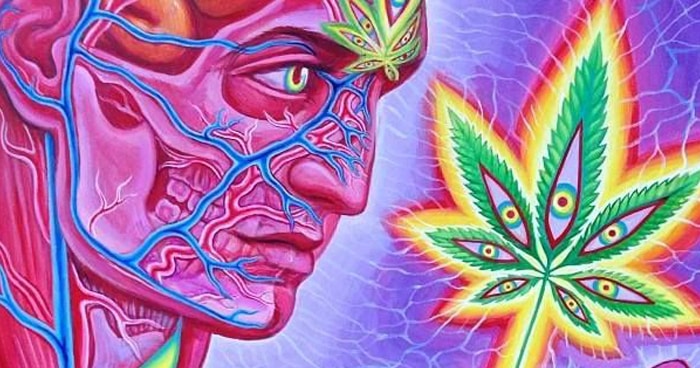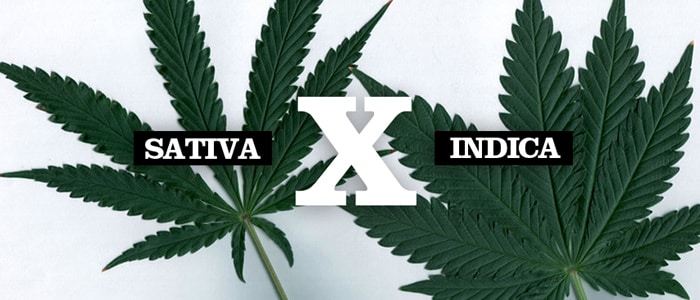Everything You’ve Ever Needed to Know About Cannabis

Artwork by Alex Grey
Cannabis, otherwise known as marijuana, is the most widely used psychoactive substance in the world. With a long standing history of medical and recreational use, this controversial plant, has been a part of humanity’s consciousness for thousands of years.
What is Cannabis and Where Did it Come From?

Artwork by Alex Grey
Cannabis is a psychoactive and multi purpose genus flowering plant with 3 species, Sativa, Indica, and Ruderalis. This plant is indigenous to central Asia and India. Cannabis has been used for hemp fibre, hemp oils, for medicinal purposes, and as a recreational drug for thousands of years. Its first known use dates back to 8,000bce. Where the use of hemp cord in pottery was identified at an ancient village site, located in the area of modern day Taiwan. Dating this at a range of over 10,000 years old, puts it as one of the first and oldest agricultural crops known to be cultivated by man.
As explained by Richard Hamilton in the 2009 Scientific American article on sustainable agriculture: “Modern humans emerged some 250,000 years ago, yet agriculture is a fairly recent invention, only about 10,000 years old … Agriculture is not natural; it is a human invention. It is also the basis of modern civilization.”
This point was also touched on by Carl Sagan in 1977 when he proposed the possibility that marijuana may have actually been world’s first agricultural crop, leading to the development of civilization itself.
Cannabis famously produces tetrahydrocannabinol (or THC), the main psychoactive element , which can be selectively bred and cured to produce different levels in a variety of species and concentrates. Cannabis concentrates can range from oils, hashish, and wax. With the rise of legalization, we are seeing a wide variety of edibles and topical ointments developed that provide the user with a variety of ways to consume the healing properties available to us. The recent discovery of CBD (cannabidiol), a non-psychoactive compound found in all cannabis, allows health professionals the ability to treat patients with minimal side effects. Developments and research about CBD’s medical benefits and properties are growing in popularity, as they are finding more ways to treat nausea, convulsions, inflammation, psychosis, tumors, anxiety and depression.
How Has Cannabis Played a Role in Human History?

The first recorded use of Cannabis as medicine is in 2,737 BCE, by Emperor Shen Neg of China. In 2,000-800 BCE, Bhang (which are dried cannabis leaves, seeds and stems) is mention in the sacred Hindu text Atharvaveda, as “sacred grass”, one of the five sacred plants of India. They used the cannabis ritually and medicinally as an offering to Shiva.
At this point, the trade of their seeds emerge on the great trade routes of the world, and the flower begins to find a sacred story within each culture, finding it’s practical influence from burial shrouds, building materials and hemp paper to eventually finding its place in legends of the hypnotic trance cannabis had on hessian armies and assassins of Persia. The etymology of “assassin” is derived from the word HASISH.
It’s not until the 20th century, due to the extreme growth of populations and western migration, do governments begin to look at cannabis use as a potential threat of controlling mass populations through policy and prohibition. Through the use of press and media, begins the great demonization of cannabis, tying it to racial stereotypes of minorities, and criminal activity. Around this time, we begin to see the name “Marijuana”, as it’s being associated with Hispanic migrant workers.
Eventually, cannabis becomes tied to great counter culture movements that inspired jazz, the beatniks, and hippie generation. Cannabis slowly becomes associated with creative rebellion in the underground, and a gateway drug in the mainstream. In the early 1970’s, at the apex counter culture rebellion and civil uprising, began Nixon’s greatest folly, The War On Drugs, and with that, cannabis became public enemy number one – treated in the same context of heroin and cocaine. Globally, Cannabis is criminalized except for places with loose laws like Holland.
In the late 1990’s the decriminalization of cannabis for medical use began in California. Over the next few years, studies open up on the potential benefits and uses for Cannabis in treating chronic illness and humanities greatest threat, Cancer.
In early 2012, Cannabis legalization begins to take shape in Colorado and Washington State. Over the course of a few years, we begin to see the financial benefits each state is experiencing during this green rush.
In 2015, nearly $900 million of cannabis products were sold in Colorado. There are three types of state taxes on recreational marijuana: The standard 2.9 percent sales tax, a 10 percent “special” marijuana sales tax and a 15 percent excise tax on wholesale marijuana transfers. Colorado collected $10.7 million in recreational taxes and fees, and more than $1.5 million in medical, bringing the 2015 cumulative revenue total to more than $121 million.
Indica or Sativa? Which Strain is Right For You?

The effects of cannabis are defined by the species and how it’s consumed. Growers are finding ways to cross strains to breed hybrids, which offer very unique characteristics. The two most popular types are Indica and Sativa. Ruderalis isn’t as popular since it grows like a weed, and only has trace amounts of THC or CBD. The effects of these plants are dependent on the individual, yet they hold some common characteristics that can be better understood by the strain.
Sativa are physically the largest, and most sought after. They grow close to the equator and continue to grow as they flower, with plants being known to reach heights of 20ft. They are loosely branched, and have long narrow leaves, popular with outdoor grows. This strain has high concentrations of THC and relatively low levels of CBD. When consumed, the high is known to be more cerebral and mental. It’s energizing, and uplifting, and can act as a motivator that increases creativity. Sativa allows the increase of focus and alertness, while promoting a sense of well being. It increases appetite, while reducing nausea, and Sativa is most associated with daytime use. In the medical marijuana field, its difficult to find 100% pure Sativa strain due to cultivation difficulty in the northern hemisphere. Yet, you can find strains where Sativa traits are most dominate, and these strains include Haze, Kali Mist, Jack Herer, Trainwreck and Durban Poison.
Indica plants are short and bushy with wide leaves, making it ideal for indoor grows. They stop growing once they begin to flower. Indica also has high CBD content, and when consumed, the high is relaxed, and most associated as a “body high”. It relaxes the muscles, reduces inflammation, and is effective in pain relief/treatment. It’s a powerful sleeping aid, acting as a sedative. It increases the appetite, and dopamine production, while relieving stress and anxiety, and is ideal for nighttime use. The most common Indica strains are Afghani, Pakistani, Hashplant, Herijuana, Northern Lights, Hindu Kush and G-13.
What Are the Effects?

When dried cannabis is smoked, it’s effects come on within a few minutes, and tend to linger for almost 3 hours. When you consume more than once in a day, it will build a tolerance to the strain, and also diminish the high. The rise of vaporizing cannabis has become popular, since it allows you to consume THC and CBD without combusting plant material that is unnecessary.
When cannabis is cooked into food and ingested orally, it can take upwards of 45 minutes to 1 hour to feel the initial effects. It needs to be metabolized through the stomach, and depends on whether you’ve eaten or if you stomach is empty. Those with a high metabolism will usually feel the effects come on quicker and it can linger for upwards of 4 hrs.
It’s important for a user to know their dosage, or they could easily consume too much and experience the negative side effects. This experience is known as ‘couch-lock’, when the user finds it difficult to move or speak. This usually leads to a false notion of “overdosing”, but it’s physically impossible. The best remedy for this is to eat food, drink water and wait it out.
Links

